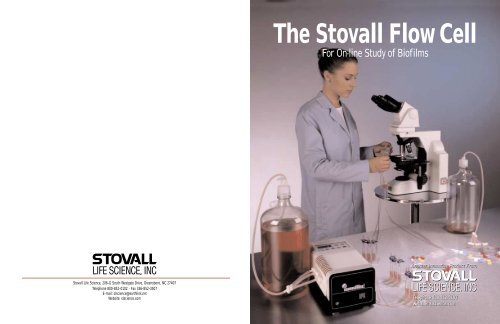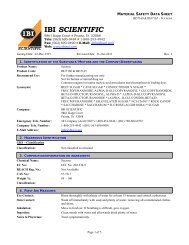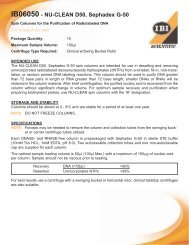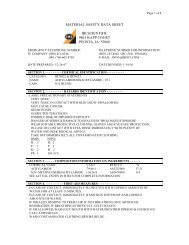Create successful ePaper yourself
Turn your PDF publications into a flip-book with our unique Google optimized e-Paper software.
<strong>Stovall</strong> Life Science, 206-G South Westgate Drive, Greensboro, NC 27407<br />
Telephone 800-852-0102 • Fax 336-852-3507<br />
E-mail: slscience@earthlink.net<br />
Website: slscience.com<br />
<strong>The</strong> <strong>Stovall</strong> <strong>Flow</strong> <strong>Cell</strong><br />
For On-line Study of Biofilms<br />
Anohter Innovative Product From<br />
Telephone Telephone 800-852-0102<br />
800-852-0102<br />
Website: Website: slscience.com<br />
slscience.com
CONTINUOUS CONTINUOUS CULTURE CULTURE CHAMBERS CHAMBERS FOR FOR REAL REAL TIME, TIME,<br />
NON NON DESTRUCTIVE, DESTRUCTIVE, MICROSCOPIC MICROSCOPIC STUDY STUDY<br />
OF BIOFILMS BIOFILMS<br />
<strong>Stovall</strong> Life Science offers<br />
the biofilm investigator an affordable, sterile, consumable flow<br />
cell apparatus for creation of biofilms, and for direct, nondestructive,<br />
on-line microscopic examination of biofilms. <strong>The</strong><br />
gamma irradiated flow cell, bubble trap and connective tubing<br />
necessary for experiments is completely assembled in its<br />
airtight package, and needs only to be opened and connected<br />
to a reservoir of culture medium and a peristaltic pump to start<br />
a biolfilm experiment. This single use set-up eliminates the<br />
possibility of carryover from one experiment to the next, and<br />
eliminates time consuming sterilization methods which either<br />
require equipment not easily accessible to most researchers<br />
(ethylene oxide chambers) or are, in fact, disinfection methods<br />
(hypochlorite). Moreover, the bubble trap design creates a low<br />
positive pressure on the flow of medium, thus mitigating the<br />
undesirable peristaltic pulsation in<br />
liquid delivery to the flow cell.<br />
➤<br />
Traditional vs. confocal<br />
microscopy for study of biofilms.<br />
Traditional transmission light microscopy<br />
may be used to follow biofilm development.<br />
However, as the biofilm thickness increases,<br />
it becomes more difficult to obtain good<br />
images due to the contribution from<br />
unfocused parts of the viewing field. Above,<br />
the scanning confocal laser microscope<br />
solves this problem by scanning several<br />
planes interspersed by short distances, thus<br />
reconstructing virtual three-dimensional<br />
images of the biofilm.<br />
ELEMENTS OF THE CONTINUOUS FLOW CELL SYSTEM<br />
As illustrated below, the assembled flow cell system consists of the following:<br />
A three outlet manifold disperses medium<br />
to sturdy pump tubing which locate in the<br />
peristaltic pump cassettes.<br />
➤<br />
A triple cylinder bubble trap with air<br />
release cocks is located immediately after<br />
the pump.<br />
➤<br />
Bubble Trap<br />
<strong>The</strong> triple cylinder bubble trap with<br />
air release cocks captures air bubbles<br />
released from the flowing culture<br />
medium. Inside the cylinder a<br />
"fountain" spout directs the flow of<br />
liquid upward for better release of air<br />
bubbles. <strong>The</strong> air release cocks allow<br />
the investigator to control the amount<br />
of air captured & govern the pressure<br />
on the passing liquid to help mitigate<br />
peristaltic pulsation.<br />
Single 3 Channel flow cell with tubing<br />
attached & glass cover slip.<br />
<strong>The</strong> triple channels of the flow cell are<br />
covered with a #1 glass cover slip, attached<br />
to the cell with acrylic adhesive. <strong>The</strong> cover<br />
slip can be scored & removed for access to<br />
the biofilm for further analysis. Each channel<br />
measures 1 mm D x 4 mm W x 40 mm L.<br />
Influent & effluent tubing is attached by<br />
barbed fittings. Write-on multicolored flags<br />
index the tubing at two junctures.<br />
Luer Connector & Tube Rack for<br />
Effluent Capture.<br />
<strong>The</strong> luer connectors in the effluent<br />
tubing can be unlocked briefly to<br />
collect effluent for analysis. <strong>The</strong> tube<br />
rack accessory for effluent capture is<br />
also illustrated here.<br />
Write on flags to keep lines<br />
organized & record injections, etc.<br />
Three feet of PVC tubing connects the<br />
bubble trap to each of the three chambers<br />
in the flow cell, each chamber measuring<br />
1 mm deep, 4 mm wide and 40 mm long.<br />
➤<br />
➤<br />
References for the <strong>Stovall</strong> <strong>Flow</strong> <strong>Cell</strong><br />
Apparatus<br />
Prototypes of the <strong>Stovall</strong> flow cell apparatus have been<br />
used successfully for biofilm cultures by numerous<br />
scientists over the past 3 years. Below are publications<br />
by some of these investigators who have used the flow<br />
cell apparatus:<br />
Christensen BB, Sternberg C, Andersen JB, Palmer RJ Jr, Nielsen<br />
AT, Givskov M, Molin S.<br />
Molecular tools for study of biofilm physiology.<br />
Methods Enzymol. 1999;310:20-42. Review.<br />
Heydorn A, Ersboll BK, Hentzer M, Parsek MR, Givskov M, Molin<br />
S. Related Articles<br />
Experimental reproducibility in flow-chamber biofilms.<br />
Microbiology. 2000 Oct;146 ( Pt 10):2409-15.<br />
Mathee K, Ciofu O, Sternberg C, Lindum PW, Campbell JI, Jensen<br />
P, Johnsen AH, Givskov M, Ohman DE, Molin S,<br />
Hoiby N, Kharazmi A.<br />
Mucoid conversion of Pseudomonas aeruginosa by hydrogen peroxide:<br />
a mechanism for virulence activation in thecystic fibrosis lung.<br />
Microbiology. 1999 Jun;145 ( Pt 6):1349-57.<br />
Nielsen AT, Tolker-Nielsen T, Barken KB, Molin S.<br />
Role of commensal relationships on the spatial structure of a surface-attached<br />
microbial consortium.<br />
Environ Microbiol. 2000 Feb;2(1):59-68.<br />
Ramos C, Licht TR, Sternberg C, Krogfelt KA, Molin S.<br />
Monitoring bacterial growth activity in biofilms from laboratory flow chambers,<br />
plant rhizosphere, and animal intestine.<br />
Methods Enzymol. 2001;337:21-42.<br />
Sternberg C, Christensen BB, Johansen T, Toftgaard Nielsen A,<br />
Andersen JB, Givskov M, Molin S. Related Articles<br />
Distribution of bacterial growth activity in flow-chamber biofilms.<br />
Appl Environ Microbiol. 1999 Sep;65(9):4108-17.<br />
Tolker-Nielsen T, Molin S.<br />
Spatial Organization of Microbial Biofilm Communities.<br />
Microb Ecol. 2000 Aug;40(2):75-84.<br />
<strong>The</strong> effluent tubing is interrupted by luer connectors which can be unlocked briefly for<br />
collection of effluent from any biofilm chamber for analysis. <strong>The</strong> coiled excess of tubing<br />
in the system is necessary to allow placement of the flow cell on a microscope platform<br />
without disturbing the flow of medium to the growth chambers.<br />
Pinch clamps to control<br />
innoculant movement or to<br />
control back flow when<br />
sampling effluent.<br />
➤<br />
<strong>The</strong> triple chambers of the flow cell are<br />
covered with a #1 glass cover slip,<br />
attached to the flow cell with acrylic<br />
adhesive. <strong>The</strong> coverslip can be scored &<br />
removed for access to the bacteria for<br />
further analysis. <strong>The</strong> flanges at each end<br />
of a flow cell provide attachments for the<br />
microscope platform.<br />
HARDWARE FOR START UP LABORATORIES<br />
Many labs are already adequately equipped to use the <strong>Stovall</strong> flow cell perfusion system.<br />
However, for those labs needing set up equipment, <strong>Stovall</strong> offers the various hardware<br />
elements which can be purchased in part or whole for biofilm experiments.<br />
4 liter or 10 liter autoclavable<br />
medium containers with<br />
fittings & tubing<br />
attachments. <strong>The</strong> 4 liter<br />
container is illustrated.<br />
Clear polycarbonate.<br />
Autoclavable.<br />
➤<br />
An Ismatec peristaltic pump with 4,<br />
8 or 12 pump cassettes. <strong>The</strong> 12<br />
cassette pump is illustrated.<br />
A two shelf rolling cart (24" W x 40"L x 33" H) to deliver<br />
the experiment to a microscope for periodic nondestructive<br />
observation.<br />
Several feet of tubing takes the<br />
effluent to another manifold and<br />
consequently to a waste<br />
container.<br />
➤<br />
4-liter effluent container<br />
with fittings & tubing<br />
attachments. Clear<br />
polycarbonate.<br />
Autoclavable.<br />
Each flow cell has three separate growth channels and each channel requires a single<br />
pump cassette to supply culture medium to it. <strong>The</strong> <strong>Stovall</strong> cart is designed to accommodate a<br />
maximum of 4 flow cells (I.E.: 12 growth channels) for a single experiment.<br />
Custom Coatings for <strong>Flow</strong> <strong>Cell</strong> Glass Cover Slips.<br />
<strong>The</strong> standard three chambered flow cell has a #1 glass coverslip (0.13 - 0.16 mm thick) attached.<br />
<strong>Stovall</strong>, in conjunction with specialized suppliers, can offer a wide range of metal, polymer and<br />
other coatings for the glass coverslips. <strong>The</strong>se thin coatings do not interfere with microscope online<br />
observations of the development of the biofilms attached to the coated glass. Write or call us<br />
to discuss the kinds of coatings you require for your experiments.<br />
Our e-mail address is slscience@earthlink.net.<br />
Telephone 800-852-0102 or visit our Website at: slscience.com





